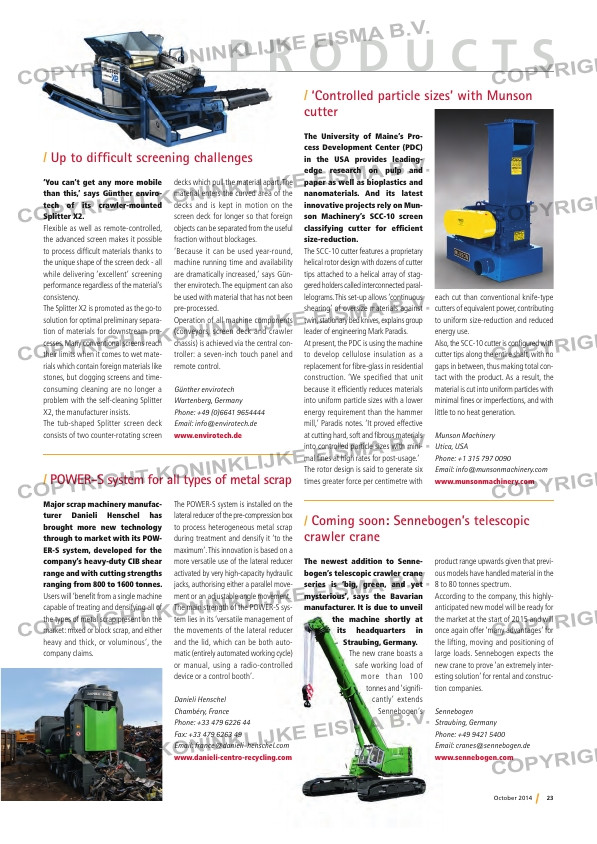Page 23 from: October 2014

23October 2014
P R O D U C T S
POWER-S system for all types of metal scrap
Coming soon: Sennebogen’s telescopic
crawler crane
‘Controlled particle sizes’ with Munson
cutter
Major scrap machinery manufac-
turer Danieli Henschel has
brought more new technology
through to market with its POW-
ER-S system, developed for the
company’s heavy-duty CIB shear
range and with cutting strengths
ranging from 800 to 1600 tonnes.
Users will ‘benefi t from a single machine
capable of treating and densifying all of
the types of metal scrap present on the
market: mixed or block scrap, and either
heavy and thick, or voluminous’, the
company claims.
The POWER-S system is installed on the
lateral reducer of the pre-compression box
to process heterogeneous metal scrap
during treatment and densify it ‘to the
maximum’. This innovation is based on a
more versatile use of the lateral reducer
activated by very high-capacity hydraulic
jacks, authorising either a parallel move-
ment or an adjustable angle movement.
The main strength of the POWER-S sys-
tem lies in its ‘versatile management of
the movements of the lateral reducer
and the lid, which can be both auto-
matic (entirely automated working cycle)
or manual, using a radio-controlled
device or a control booth’.
Danieli Henschel
Chambéry, France
Phone: +33 479 6226 44
Fax: +33 479 6263 49
Email: [email protected]
www.danieli-centro-recycling.com
The newest addition to Senne-
bogen’s telescopic crawler crane
series is ‘big, green, and yet
mysterious’, says the Bavarian
manufacturer. It is due to unveil
the machine shortly at
its headquarters in
Straubing, Germany.
The new crane boasts a
safe working load of
more than 100
tonnes and ‘signifi –
cantly’ extends
Sennebogen’s
product range upwards given that previ-
ous models have handled material in the
8 to 80 tonnes spectrum.
According to the company, this highly-
anticipated new model will be ready for
the market at the start of 2015 and will
once again offer ‘many advantages’ for
the lifting, moving and positioning of
large loads. Sennebogen expects the
new crane to prove ‘an extremely inter-
esting solution’ for rental and construc-
tion companies.
Sennebogen
Straubing, Germany
Phone: +49 9421 5400
Email: [email protected]
www.sennebogen.com
‘You can’t get any more mobile
than this,’ says Günther enviro-
tech of its crawler-mounted
Splitter X2.
Flexible as well as remote-controlled,
the advanced screen makes it possible
to process diffi cult materials thanks to
the unique shape of the screen deck – all
while delivering ‘excellent’ screening
performance regardless of the material’s
consistency.
The Splitter X2 is promoted as the go-to
solution for optimal preliminary separa-
tion of materials for downstream pro-
cesses. Many conventional screens reach
their limits when it comes to wet mate-
rials which contain foreign materials like
stones, but clogging screens and time-
consuming cleaning are no longer a
problem with the self-cleaning Splitter
X2, the manufacturer insists.
The tub-shaped Splitter screen deck
consists of two counter-rotating screen
decks which pull the material apart. The
material enters the curved area of the
decks and is kept in motion on the
screen deck for longer so that foreign
objects can be separated from the useful
fraction without blockages.
‘Because it can be used year-round,
machine running time and availability
are dramatically increased,’ says Gün-
ther envirotech. The equipment can also
be used with material that has not been
pre-processed.
Operation of all machine components
(conveyors, screen deck and crawler
chassis) is achieved via the central con-
troller: a seven-inch touch panel and
remote control.
Günther envirotech
Wartenberg, Germany
Phone: +49 (0)6641 9654444
Email: [email protected]
www.envirotech.de
The University of Maine’s Pro-
cess Development Center (PDC)
in the USA provides leading-
edge research on pulp and
paper as well as bioplastics and
nanomaterials. And its latest
innovative projects rely on Mun-
son Machinery’s SCC-10 screen
classifying cutter for effi cient
size-reduction.
The SCC-10 cutter features a proprietary
helical rotor design with dozens of cutter
tips attached to a helical array of stag-
gered holders called interconnected paral-
lelograms. This set-up allows ‘continuous
shearing’ of oversize materials against
twin, stationary bed knives, explains group
leader of engineering Mark Paradis.
At present, the PDC is using the machine
to develop cellulose insulation as a
replacement for fi bre-glass in residential
construction. ‘We specified that unit
because it effi ciently reduces materials
into uniform particle sizes with a lower
energy requirement than the hammer
mill,’ Paradis notes. ‘It proved effective
at cutting hard, soft and fi brous materials
into controlled particle sizes with mini-
mal fi nes at high rates for post-usage.’
The rotor design is said to generate six
times greater force per centimetre with
each cut than conventional knife-type
cutters of equivalent power, contributing
to uniform size-reduction and reduced
energy use.
Also, the SCC-10 cutter is confi gured with
cutter tips along the entire shaft, with no
gaps in between, thus making total con-
tact with the product. As a result, the
material is cut into uniform particles with
minimal fi nes or imperfections, and with
little to no heat generation.
Munson Machinery
Utica, USA
Phone: +1 315 797 0090
Email: [email protected]
www.munsonmachinery.com
Up to diffi cult screening challenges
RI8-Product News.indd 23 06-10-14 14:05



